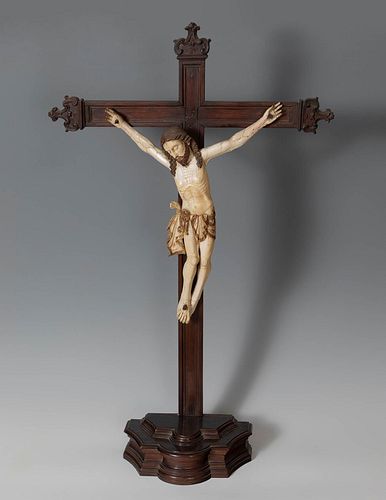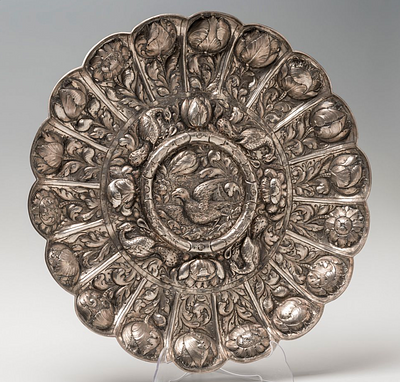Indo-Portuguese school, XVII century. "Crucified Christ".
Lot 82
About Seller
Setdart Auction House
Carrer Aragó 346
Barcelona
Spain
Setdart Subastas was born in 2004 and is currently the first online art auction in Spain with solidity, prestige and reliability guaranteed by our more than 60,000 users. Setdart has a young, dynamic and enterprising team ready to successfully manage the purchase and sale of art works through custom...Read more
Categories
Estimate:
EUR€9,000 - EUR€10,000
$9,677.42 - $10,752.69
Absentee vs Live bid
Two ways to bid:
- Leave a max absentee bid and the platform will bid on your behalf up to your maximum bid during the live auction.
- Bid live during the auction and your bids will be submitted real-time to the auctioneer.
Bid Increments
| Price | Bid Increment |
|---|---|
| EUR€0 | EUR€10 |
| EUR€200 | EUR€25 |
| EUR€500 | EUR€50 |
| EUR€1,000 | EUR€100 |
| EUR€3,000 | EUR€200 |
| EUR€5,000 | EUR€500 |
| EUR€10,000 | EUR€1,000 |
| EUR€20,000 | EUR€2,000 |
| EUR€50,000 | EUR€5,000 |
About Auction
By Setdart Auction House
Jul 13, 2021
Set Reminder
2021-07-13 07:00:00
2021-07-13 07:00:00
America/New_York
Bidsquare
Bidsquare : DECORATIVE ARTS XV-XIX
https://www.bidsquare.com/auctions/setdart-auction-house/decorative-arts-xv-xix-7201
Setdart Auction House sofia@setdart.com
Setdart Auction House sofia@setdart.com
- Lot Description
Indo-Portuguese school, XVII century. "Crucified Christ". Carved ivory, polychrome and gilded details. Cross in carved wood. Attached CITES. Measures: 44 x 33 cm. figure. High quality ivory carving representing Christ crucified. In spite of his closed eyelids and tilted head, it is an expiring Christ, which is revealed in his body in tension. The half-open mouth exhales a last sigh. The characteristic way of carving the hair of the Indo-Portuguese school, consisting of curls in the shape of a snail, with linear incisions marking the direction of the hair, can be appreciated. Also typical of this school are the almond-shaped eyes, the straight nose and the mouth with barely marked lips. The anatomy, however, follows directly the European models of the Baroque; it is a suffering anatomy, which reveals the physical exhaustion of Christ, worked with the naturalism typical of an art that seeks to make the faithful identify with the sacred scene represented, to be moved by the suffering of the Savior. The veins of the arms, the tendons of the feet, the marked ribs and the perfectly modeled muscles let us appreciate the quality of the carving. Through the commercial routes that linked Europe, America and the Indies, various oriental products arrived to the Iberian Peninsula, in most cases considered luxury items, among which the pieces made of ivory stood out. Both the royal families and the nobility and people of high social position desired exotic objects for their collections, being those of ivory among the most prized, both for the value and exoticism of the material and for the quality of the work. These carvings also had a double function. In the first place, they were precious and decorative objects, but they also had a didactic and evangelizing purpose, as they were carved with Christian themes and iconography, using decorative motifs, elements and techniques typical of the Far East. In general terms, the missionaries commissioned local artists to make them, showing them European models to imitate. This type of pieces, destined for Portuguese clients, were made especially in Goa (India), also an important center of furniture manufacturing. The artists of that area had a long tradition of ivory sculpture, so the result was a synthesis of the local aesthetic heritage (emphasis on the textures of clothing and objects, importance of animalistic representation, etc.), with Western iconography and taste.
- Shipping Info
-
In-house shipping available. Please inquire at admin@setdart.com.
-
- Buyer's Premium



 EUR
EUR CAD
CAD AUD
AUD GBP
GBP MXN
MXN HKD
HKD CNY
CNY MYR
MYR SEK
SEK SGD
SGD CHF
CHF THB
THB


















